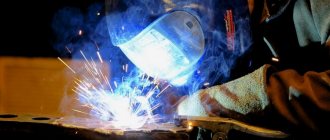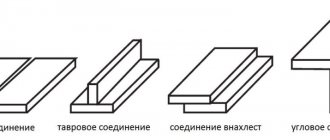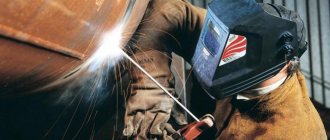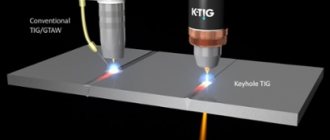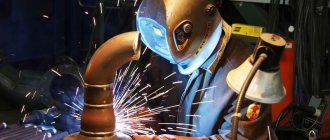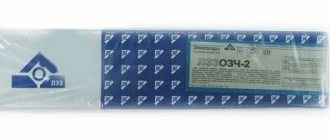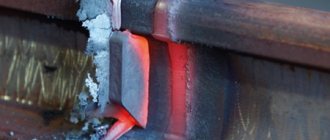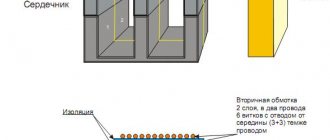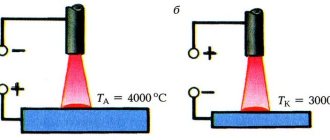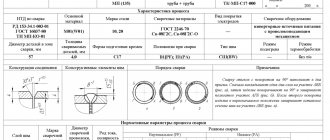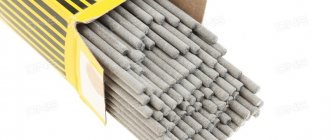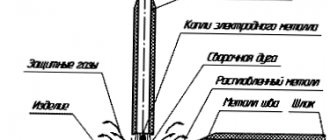02/24/2020 Author: VT-METALL
Issues discussed in the material:
- About the preparatory stage of arc welding of pipes
- How to choose electrodes for arc welding of pipes
- Pipe arc welding methods
- Features of arc welding of pipes at low temperatures
- How to check the quality of arc welding of pipes
Arc welding of pipes has its own characteristics, which are expressed not only in the type of connections, but also in carrying out certain manipulations depending on the ambient temperature. Depending on the type of pipe and weather conditions, appropriate electrodes are selected and preparatory operations are carried out.
In addition to the correct choice of electrodes and other devices, it is necessary to decide on the welding technique. There are several approaches that are used by modern masters. We will talk about all this in more detail in our article.
Preparatory stage of arc welding of pipes
Let's start with the equipment needed for the work, in addition to the welding machine. The welder's workplace is called a welding station, which is equipped with tools such as:
- electrode storage box;
- electric holder;
- set of probes;
- hammer;
- chisel;
- emery;
- tin tray for cinders;
- metal brush;
- power cable for arc welding;
- set of templates;
- protective equipment (helmet, shields).
The welding cable must be flexible and have a sufficient length for the given cross-section that does not hinder the work of the welder.
The helmet and shields are designed to protect the face and especially the eyes during work. They are necessary, since the radiation generated during arc welding negatively affects the skin. The helmet is usually made of fiber or specially prepared plywood and weighs up to 600 g when finished. Amateur welders sometimes neglect such protection because, in their opinion, it interferes with their work. But this excuse is wrong, because a properly used helmet or visor should not cause any inconvenience.
A 6x12 cm cutout is made on the front side of the helmet, which is quite enough for full observation of the process. If you make your own protective shield, you should keep in mind that the sight glass must be special, not transmitting radiation in the infrared and ultraviolet ranges. On the outside, this filter can be additionally equipped with ordinary glass to protect against splashes.
We recommend articles on metalworking
- Steel grades: classification and interpretation
- Aluminum grades and areas of their application
- Defects in metal products: causes and search methods
Another important welding device is the electric holder. This tool must be mounted at any angle to protect against overheating, and must also weigh no more than 500 g. In addition, it is necessary to ensure reliable insulation of the holder from the effects of electric current. If we consider the three types of electrical holders offered on the market (pincer, fork, with a spring ring), it is better to make a choice in favor of the first.
The overall quality of welding depends on proper preparation. Therefore, before starting welding work, you should perform a number of steps, which are given below:
- Checking details.
All elements from which the welding system is assembled must be carefully inspected. Check the dimensions of each part (length, thickness, diameter), composition, and also make sure there are no defects, damage or deformations.
- Edge preparation.
The edges of the parts to be welded are first cleaned of traces of corrosion, dirt, oil and moisture. To do this, use a needle mill or a regular brush. It is also recommended to degrease the edges. In order for arc welding to be performed with the highest quality possible, the edges of the pipes are straightened with mandatory gap control. If access to the edges is difficult, use a gas burner to heat them or treat the gap with compressed air.
- Checking the bevel.
Check the bevel angle and the amount of bluntness - they should be in the ranges of 60–70 mm and 2–2.5 mm, respectively. If, after mechanical cutting, work hardening has formed on the edges, and there is also a casting skin, these defects should be removed with an emery stone.
5. Welding pipes using electric welding in shielding gases: argon arc welding.
Modes:
- When welding in one pass, the welding current depends on the wall thickness of the part, and when welding in multiple passes, on the height of the bead. For each mm of electrode diameter, 30-35 A is assigned.
- The arc voltage is kept to a minimum, which corresponds to short arc welding.
- The welding speed is adjusted to ensure that the edges are fused and the dimensions of the seam are formed.
- Argon consumption depends on the steel grade, welding current mode and ranges from 8 to 14 l/min.
- It is necessary to weld a continuous seam immediately after installing the tacks, which should be remelted when performing the first layer.
- The argon supply stops only 5-8 seconds after the arc breaks.
Selecting electrodes for arc welding of pipes
- For gas pipelines.
To connect pipes that will be used to transport main gas, as well as tubing pipelines, it is advisable to use OK-46, LB-52 or UONI-13/55 electrodes. These grades may contain manganese, phosphorus, silicon and sulfur, which is quite suitable for these purposes. Among these electrodes, OK-46 is the most versatile, since their surface is covered with a rutile layer. This option is especially convenient when arc welding large gaps.
But it’s worth considering another brand – LB 52U with basic coating. Such electrodes contain a relatively small proportion of hydrogen, which ensures high quality welds. The arc ignites quickly and remains stable, fully welding the metal parts being connected.
In the case of arc welding of critical pipe elements (for example, rotary pipes) made of carbon or low-alloy steel, experts advise using special MTG-01K electrodes. The latter provide a stable arc with rapid slag removal and the formation of a small amount of spatter.
- For heating pipes.
For this case, electrodes E42A and UONI 13/45 with a diameter of 3 mm are considered the most suitable. They are equipped with a thick coating that allows you to work with carbon steel. Heating pipes can also be welded with electrodes of the E-09X1MF and TsL-20 brands. These rods provide a strong weld on heat-resistant steel pipelines. As in the case of E42A and UONI 13/45, the coating of these electrodes is quite thick. The TsL-9 grade with a base coating is recommended for arc welding of pipes made of alloy, carbon steel, and stainless steel. Due to their low hydrogen content, these electrodes provide excellent weld quality.
When arc welding heating pipelines designed for increased pressure of continuously supplied water, as well as tubing pipes, electrodes of the MP-3 brand should be used. These rods have a diameter of 3–5 mm, are made of special wire and coated with a rutile layer. To ensure maximum tightness of the seam, you need to weld with a short arc, tilting the electrode towards the deposition.
Pre-setting the current is important. The voltage should not be too low to weld the metal, and not too high to avoid deformation of the parts being connected. In this regard, both the thickness of the metal wall and the dimensions of the electrode should be taken into account.
- For plumbing.
In this case, the choice of electrode brand depends on the metal. For copper pipelines use MN-5, MNZh5, for stainless steel pipes - NZH-13, for cast iron - MNCh-2. If arc welding is performed at home using an inverter, and pipes made of ferrous metal are welded, the use of MP-3s electrodes is allowed. Such rods are capable of connecting walls 2.8 mm thick in a pipeline with a diameter of 32 mm, for which a low current is sufficient.
Electrodes of the MNCh-2 brand are used to weld vertical seams, and TsCh-4 are used for both cold and hot welding, but subject to the lower position of the rod. Regardless of the brand, each electrode must have a protective coating (coating) that protects the welding zone from oxidation. To connect pipes, whenever possible, choose rods with a thick coating.
Technology
Electrodes are selected for the root seam 2 - 3 mm, subsequent ones are thicker. If the wall thickness is more than 12 mm, it is possible to use ANO and UONI grade rods with a thickness of 6 mm on the last layer.
Welding is performed using a DC inverter or transformer. To work in the field with large-diameter parts, rectifiers are used.
On direct current they cook with reverse polarity, applying minus to the part. Alternating current is used for aluminum, non-ferrous alloys and high-alloy steels.
The arc must be kept short, it should not touch the parts being welded, just direct the bath to the right place. Care should be taken to ensure that the slag has time to melt and float.
Parts must be cleaned of dirt and oxides. Edge cutting is not done at the enterprise when rolling products or on a machine as an afterthought.
Pipe arc welding methods
Pipes are usually welded by hand in 2-3 layers, even with a small thickness of the edges being joined. Multilayer arc welding produces a high density seam, which is welded faster. Next, we will analyze the main methods of connecting pipelines using manual arc welding: with and without turning the joints.
- Welding a vertical joint without rotation.
The seam here is formed in two stages. Initially, the welded joint along the perimeter is divided into two sections by a vertical center line. Each segment occupies three positions at certain moments:
- ceiling (1–3);
- vertical (4–8);
- lower (9–11).
Welding of a section in the ceiling position is performed exclusively with a short arc, subject to the following conditions:
lmin=0.5 × d (mm),
where d is the diameter of the electrode.
Finish the seam when it is in the bottom position.
You need to start cooking, moving from the vertical center line by 10–20 mm. The overlapping seams form what is called a lock joint. Its length varies from 20 to 40 mm depending on the diameter of the pipeline. Accordingly, the larger the pipe, the longer the “lock” should be.
In the ceiling position, the seam is welded with a “backwards angle”, and when moving to a vertical position – with a “forward angle”. As soon as the arc welding reaches point 8, the electrode is positioned perpendicularly. In the lower position, cook again at an angle back.
After completing the processing of the first section, you should prepare the second by cleaning its starting and ending points and smoothly moving to the gap or to the previous seam. The sequence of actions when welding is the same.
The root seam is formed with an electrode with a diameter of 3 mm. It is recommended to vary the current strength depending on the position: for ceiling – 80–95 A, for vertical – 75–90 A, for bottom – 85–100 A.
Good quality of the seam without back welding is achieved due to the constant presence of the rod in the gap. The seam melted inside the pipe appears as a convex surface that requires mechanical cleaning in the ceiling position.
If the pipe thickness exceeds 8 mm, the groove is filled unevenly, usually with a lag in the lower position. To level the filling, an additional bead should be welded in the upper position. In the penultimate welded layers, the groove should not be filled to a depth of 2 mm. The formation of a facing seam is carried out in one or several stages.
Upon completion of the penultimate roller, the groove should be left unfilled to a depth of 0.5 to 2 mm. In this case, along the cutting edges, the metal must be melted to the width of half the diameter of the electrode.
Working with gas pipelines and pipes for transporting aggressive liquids
Ceramic spacers are used to form the root seam. They are attached to the reverse side and form molten metal, preventing it from leaking out. Ceramic gaskets prevent porosity, undercuts and sagging.
Welder of the 6th category, foreman of a team of welders of equipment for the food and chemical industries Boroday N.S.: “When welding critical pipes and stainless steel containers, the formation of beads on the inside is not allowed. When laying the root weld, it is necessary to ensure that argon is blown into the welding area. If it is impossible to use argon locally, it is pumped into a container or pipe, ensuring airflow throughout the entire root weld welding with an intensity of 3 - 4 l/min. When accessing the inside of the structure to be welded, flux paste is applied to the back of the seam, diluted with alcohol to the consistency of toothpaste. It will help form an even seam and prevent the formation of aggregation – hedgehogs.”
Arc welding of pipes at low temperatures
Most metals experience an increase in the limits of hardness, strength and fluidity as their temperature decreases. On the one hand, the changed properties could be used by increasing the permissible stresses for the material in order to facilitate structures. But, on the other hand, stress concentration is present in one way or another in almost all structures. And as the temperature drops, metals become much more sensitive to damage.
In this case, the properties of metals can change in different ways, depending on several parameters: crystal lattice, grain size, chemical composition, and the nature of heat treatment. The load exerted on the material and its stress state also influence. If, with a decrease in the temperature of the metal or alloy, the yield strength increases slightly relative to the tensile strength, such a material is considered cold-resistant. Its impact strength and ductility remain almost unchanged. If the difference between the changes in the yield strength and the ultimate strength is much more significant, and the ductility drops sharply, the metal is classified as cold-brittle.
Arc welding of pipes at low ambient temperatures causes the metal in the weld pool to cool and crystallize very quickly. As a result, some of the gases and oxides do not have time to leave the surface of the weld, which increases the content of oxygen, nitrogen, hydrogen and non-metallic compounds in it. This causes the appearance of numerous pores, cracks of hot and cold origin. The greater the likelihood of “hot” cracks appearing, the faster the elasto-plastic deformation occurs at temperatures where the metal is in a brittle state.
Welding materials at low temperatures also lose their useful properties. Due to moisture ingress, the weld metal becomes too porous. To protect electrodes, fluxes and wires from water, you need to not only store them properly and dry them in a timely manner. It is important to correctly select materials for work in winter in order to increase the deoxidizing ability of slags and ensure complete release of gases.
Checking the quality of arc welding of pipes
The formed weld inevitably leads to the formation of various defects in the pipe metal. Typically this occurs during the cooling or heating process. Other damage occurs due to non-compliance with welding requirements.
Emerging defects ultimately deteriorate the quality of the entire pipe, so they need to be identified and prevented in advance. We list these defects below:
- Violation of the metal structure. As a result of this flaw, a coarse-grained material is formed, and the grains along the edges are oxidized due to an increase in the oxide content.
- Increased gas content, increased porosity. Pores can form in groups, individually, or form unique bridges. Porous structures emerging on the surface of the metal are called fistulas.
- Contamination of the seam with slag. These impurities significantly reduce the initial strength.
- Formation of cracks. As a rule, they are formed near the seam and can vary in type and size.
- Lack of penetration. This word refers to local areas of the weld where there is no adhesion to the base metal.
- Burning holes in seams. Occurs as a result of leakage of molten mass from welds.
- Formation of undercuts. This is the name given to the grooves formed along the seams near the boundaries with the base metal.
- Deformation of welds.
Each of the listed defects must be identified and subsequently eliminated. Only then will it be possible to talk about the highest quality arc welding of a pipe. At the same time, the impact of each flaw on the performance of the entire pipeline is assessed. Otherwise, it will not be possible to completely eliminate the malfunction before operation.
Analysis of the quality of a pipe begins with its external inspection, both visual and using various measuring instruments. At this stage, external negative influences are identified and satisfaction with the requirements and norms of current laws is determined.
